EPA 515: Determination of Chlorinated Acidic Herbicides with a two-column System and Dual Electron Capture Detection
Introduction
The United States Environmental Protection Agency (US EPA) details a harmonised test method for the determination of chlorinated acids in water by gas chromatography with an electron capture detector (GC- ECD), EPA 515. The compounds included in the method are acidic and include phenols and carboxylic acids. The acidic herbicides require derivatisation, with the acid being converted to methyl esters. EPA 515 specifies that diazomethane is the derivatising agent to be used, however, it is vital that excess derivatising reagent is removed prior to analysis. This application note describes a derivatisation procedure using dimethylformamide dimethyldiacetal (Methyl-8), which is much easier to handle and also less hazardous than diazomethane. After derivatisation, the pesticides are separated on two columns for simultaneous analysis and confirmation using dual electron capture detectors.
Experimental
A SCION 8500 GC was equipped with a septum equipped programmable injector, dual ECDs, 8400 autosampler and CompassCDS for data handling and processing of results. The system can be visualized in Figure 1. A methylated herbicide mix was diluted to low nanogram levels in MTBE. Individual standards of each acidic compound were derivatised with Methyl-8 and injected into the GC system.
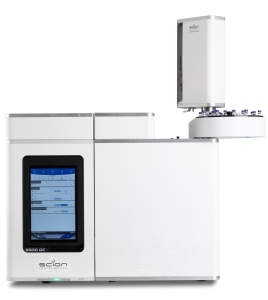
Figure 1. SCION Instruments 8500 GC equipped with an 8400 PRO Autosampler
Eighteen compounds were individually injected into the GC before derivatisation. Compounds were then weighed and mixed with 100µL each of MTBE and Methyl-8 before being incubated at 65°C for 20 minutes. Each compound was then diluted to a concentration of 1-3ng/µL and injected into the GC to verify that derivatisation had occurred. The retention time of all peaks, on both columns, were determined. Retention times were compared with those of the methylated standard mix and the published times in the EPA method. Mixes were also prepared of all of the compounds with an internal standard recommended by the EPA; 4,4’- dibromooctafluorodiphenyl (DBOB). Precision, minimum detectable quantities and detector response at different concentrations were determined.
The analytical conditions of the instrumentation can befound in Table 1.
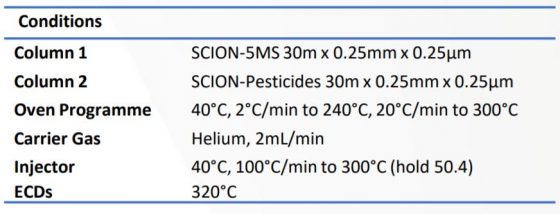
Results
The retention times of all compounds are detailed in Table 2 with the chromatogram of the mixed standard, analysed on the SCION-5ms column, shown in Figure 1. The * symbol notes that there was no compound response due to adsorption onto the column.
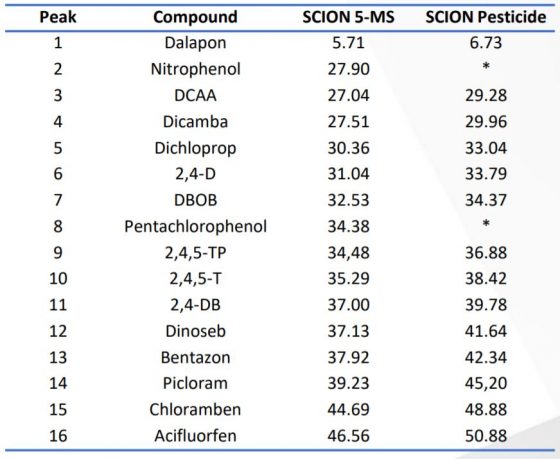
Table 2. Compound retention times on both columns
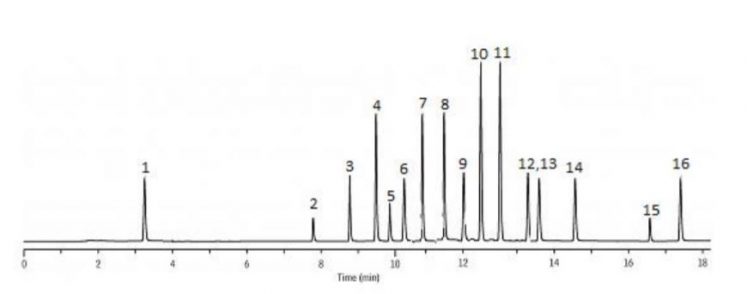
Fig 1. Chromatogram of mixed standard, analysed on a SCION-5MS column
The herbicides analysed had a wide range of volatilities. Table 3 details the precision data and minimum detectable levels (MDL) for selected compounds (n=8). The S/N for all MDLs stated was 5.

Table 3. Repeatability values of peak area and MDLs for selected compounds.
Preparing calibration standards at several concentrations ensures linearity throughout the system. Detector responses for selected compounds, at varying concentrations can be found in Figure 2.
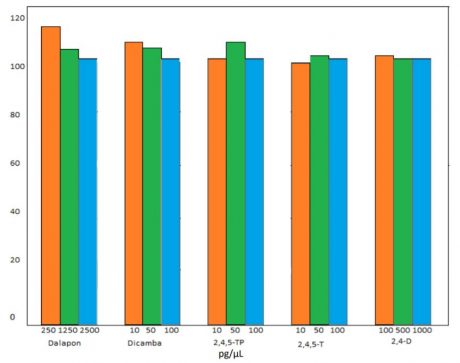
Fig 2. ECD response per picogram of selected methyl esters, at different concentrations.
Conclusion
The dual column and dual ECD system with SCION GC and programmable injector offers excellent chromatographic performance with compounds over a wide range of volatilities. Using Methyl-8 as a derivatizing agent was possible without compromising the results. The dual system shows excellent repeatability and low detection limits of acidic herbicides when analysed in accordance to EPA 515.
Download Application Note
Download the complete Application Note: Determination of Chlorinated Acidic Herbicides with a two-column System and Dual Electron Capture Detection
SCION Gas Chromatography Analyser
A SCION Gas Chromatography Analyser was used to conduct this research. Providing excellent solutions for Environmental, Oil and Gas and Chemical industries, find out more about SCION GC Analysers.
If you would like to speak to a member of our team for more information, please don’t hesitate to get in touch. Or to stay in the loop regarding future research and articles from SCION Instruments, why not join us on social media and sign up to our eNewsletter today?
